So, rather than skimp over the little details which might actually have a pretty large impact in he overall scheme of things, what we’ve done, is to try and deliver the most comprehensive look at the tech present in making up the world of Bright Falls, one of this years most defining visual achievements.
Usually it’s Sony’s PS3 exclusives that garner such attention and technical praise, often delving deep into the hardware to deliver an visual experience that on so many technical levels is almost unmatched by most other titles on competing platforms – PC of course excluded, but that’s a given really. Microsoft on the other hand, have a machine with a comprehensive set of development tools that are so much more traditional and easier to get to grips with what Sony have provided for the PS3, that in most cases developers are quite happy to think inside the established box when it comes to crafting that show-stopping visual showcase expected for current-generation games.
However, some developers such are beginning to break out of that cycle, creating a graphical experience which rivals that of Uncharted 2, Killzone 2 and God Of War 3. Both Bungie with Halo Reach, and Remedy with Alan Wake, are pushing the envelope of what is possible on MS’s machine, showing gamers and developers that what is possible in a PS3 custom-made approach title is also possible on the 360.
Last week we took an in-depth look at Halo Reach, casting our critical eye over the overall workings of the tech. Today IQGamer looks closely at Remedy’s Alan Wake, a game no stranger to controversy or our very own tech analysis, in which for this feature, we will be finally evaluating the tile whilst also attempting to fully uncover the truth behind that 540p rendering resolution.
Alan Wake, to cut away any lingering doubts or speculation does indeed render in 960x540 resolution, which is then upscaled by the 360 to form a final 720p image. Not all aspects of the game are rendered in this sub-HD resolution – with some effects actually being closer towards 720p – and the game does use an impressive 4x multi-sampling anti-aliasing at all times, a side effect of which is not only a clear reduction of jagged lines but also a much cleaner upscale.
The result of rendering in 540p isn’t quite as bad as what you might expect, with fine detail still being present, and the soft look of the game actually appearing quite clean and clear compared to some other sub-HD games. No doubt that the use of 4xMSAA actually helps in reducing any upscaling artefacts, whilst keeping the image relatively clean in the process. Softness, as obvious as it is, is the by-product of this, but its inclusion actually helps in creating the creepy atmosphere found in the game, along with the shadowy and foggy night time visuals all feeding a real sense of immersion.
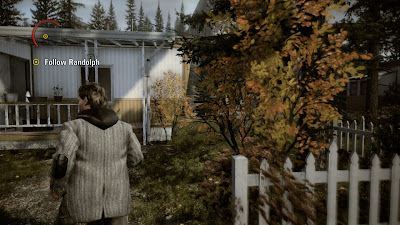
It’s pretty clear from the screenshot above just how good Alan Wake looks for a game that is decidedly more sub-HD than many others on the market. But why did Remedy opt for using such a low resolution so late in the development cycle? And what happened to claims of rendering in 720p with 4xMSAA?
Well, you only have to look at last years gameplay footage in order to find out, which does indeed render in full 720p whilst sporting 4x multi-sampling anti-aliasing. Before this, Alan Wake was rendering at the standard 720p with 2xMSAA, in addition to having full resolution particle and transparency (framebuffer) effects. However the game suffered from constant screen-tearing and drops in framerate, no doubt as the engine struggle to cope with the game’s intense bandwidth requirements
It is pretty obvious that Alan Wake as a game is extremely bandwidth heavy, rendering all those fog, mist, smoke, and transparent particle effects. Transparencies are littered all over the game’s fictional town of Bright Falls, and the engine unsurprisingly was struggling to cope.
Originally Remedy simply decided to change from rendering full resolution effects to instead using half-res alpha-to-coverage effects (A2C), thus saving some bandwidth needed to keep performance up. However, A2C has the unfortunate side effect of giving all transparencies that use it an unsightly screen door effect. The only solution is to effectively up the level of anti-aliasing to 4xMSAA in order to blend away the A2C into the rest of the scene.
Despite these changes it’s clear that the game still suffered from severe performance issues, with tearing once again being at the forefront of those. In an interview the developers stated that the screen tear would be part and parcel of the experience, a sign that maybe they where having trouble in keeping things running smoothly. In light of all this, it seems that in order to claw back performance they finally opted to render in a sub-HD resolution to give them a smooth 30fps update and very little screen tear, whilst still having all the benefits of 4xMSAA improving the overall image quality (IQ).
In the end the use of A2C does very little to damage the overall look of the game. Alan’s hair for example (see below screenshot), is using it with very little in the way of noticeable side effects, though if you look closely you can indeed see some of the dithered nature of the A2C at work. The 4xMSAA manages to prevent any noticeable upscaling effects from being visible, and the soft look provided by the lower resolution isn’t particularly intrusive.

There’s not doubt that the game would look much sharper as a result of rendering at 720p over the current 540p framebuffer, however it is likely that many of the outstanding graphical effects and small visual touches would have to have been sacrificed in order to keep performance levels up. With this in mind it’s much better to have a smoother, graphically more impressive game as a whole, than to have a clearer albeit simpler one instead.
Resolution and framebuffer issues out of the way, the rest of Alan Wake’s engine is just as interesting, and serves as a clear technical benchmark for many 360 developers to follow.
The stable framerate for one is a pretty exceptional achievement. Alan Wake maintains a rock solid 30fps ninety-nine percent of the time, with the game instead opting for screen tearing in situations where the engine is struggling to keep a steady hold on things. As a result the game basically never drops frames at all, and when it does, the drop is so insignificant that it is barely even noticeable at all. The downside is that the tearing can get pretty messy at times, covering the image right in the centre of the screen where it is most noticeable.
Thankfully, these situations aren’t too common place, with most of the tearing smoothly appearing for a split second or so, before vanishing as quickly as it came. It should be pointed out though, that the game does tear regularly, although it isn’t at all intrusive in these smaller amounts.
Adding to the stable framerate is the games use of camera-based motion blur, which helps to create that smooth look and feel that the game has throughout. The motion blur is very subtle, never at all intrusive, instead being an organic part of the camera movement. Its implementation is just another part of the artistic flair that is running through every aspect of the game’s visual make up. The screenshot below shows the effect in action, though it seldom has that much of a dramatic impact on the game in motion.
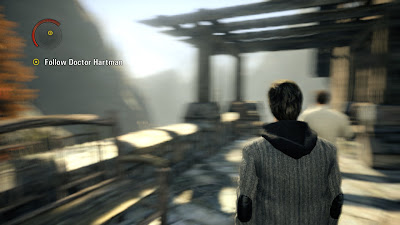
What is surprising, is that the engine in Alan Wake is running at a almost constantly solid 30fps with a high level of dynamic visual effects - from fog, smoke, and particles - whilst also capable of delivering incredible draw distances without dramatically paring back the visual through the use of an aggressive LOD system. The game is full of sprawling vistas, from dense forests to towering mountains, and all of it is largely reachable, with the player travelling between these iconic places many times.
Perhaps, it is for this reason that the game engine has had sacrifices in other areas. Both the framebuffer, alpha effects, and textures have been downgraded by using a lower resolution, as to has parts of the game’s lighting and shadow system.
Originally Alan Wake was going to be a fully-fledged open world action horror, in which the player would be investigating the various paranormal and supernatural occurrences whist trying to find wife Alice and fend off scores of ‘The Taken’. In much of the final game you can clearly see the original open world nature of its design, with large organic multiple paths to take, long draw distances, and the ability to backtrack, go off the beaten path, before heading to you next destination.
The engine used in the final game is still highly optimised for such an experience, so despite the change to a more linear and controlled affair, the engine still has to draw vast distances in high quality, whilst also having to render all those alpha effects, shaders and textures, and keep up framerate at the same time. It’s like having a version of GTA or Just Cause with Uncharted 2 levels of graphical polish, something which is beyond any of the current gen consoles.
A good example can be seen below, in which the game renders detailed scenery for miles for many miles away from the player, with no additional visual effects hiding the incredible draw distances that the engine is capable of.
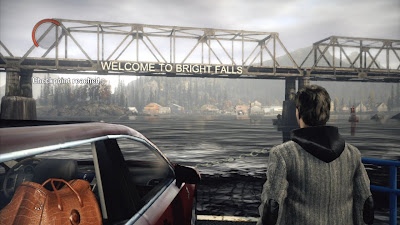
Texture detail is reasonably high, although the actual textures themselves appear to be of very low resolution. Up close any detail begins to break up, and from a distance they look clean, but at the same time a little blurry. The quality overall is very good, given the game’s 540p framebuffer and various effects that the engine is pushing around on screen, it’s just a shame that much to the intricate details get so broken up in close range, or blended away when at a distance. Nevertheless there are times in which the combination of artistic flair and attention to detail really show of the textute work.
In term s of filtering it’s not entirely clear what is going on in Alan Wake. Assessing levels of texture filtering by eye is always a difficult proposition, however it is possible to make so well placed judgements as to what is happening.
At times texture detail is visible for a good 16 feet or so into the distance before becoming blurry, whilst in other scenarios texture fidelity is lost just a few feet away from Alan himself. In these later scenes, it would appear that the game is perhaps using bilinear filtering (BF) at best, although that would fail to explain the clarity in other scenes. Instead, my best guess is that Remedy are actually using a combination of anisotropic (AF) and bilinear filtering for the textures, alternating between large amounts of AF and BF combined, to very little AF with no BF at all.
You could call this a ‘filtering bias’ with some scenes getting more filtering that others. But at the same time witn all the fog, mist and other effects going on at night, it is hard to make a solid judgement call on this. At the very least TF is definitely present, with small levels of AF in parts.

Unmistakably though, the use of high levels of visual effects such as volumetric fog, smoke, particles, and the impressively accurate dynamic lighting and shadowing system, is what puts Alan Wake above so many other titles available on either the 360 or the PS3. It’s these effects that work so well with the A2C and 4xMSAA that any hit in pure sharpness taken away by the 540p resolution isn’t on many occasions all that apparent. Especially in night time scenes in which all the visual effects come together, with loads of moving elements on screen pretty much most of the time.
The fog, shadows, light, foliage and physics based objects are cast their own shadows, some simply being pre-baked shadow maps, other being fully dynamic reacting to a multitude of light sources and environmental objects. The fog for example, interacts with the game’s lighting, with light shining through it, moving over the trees and the foliage, casting shadows for most objects in its path.
A hazy mist is also present during the environments at dusk and at night, which both reacts with light along with blending into the black fog which appears as ‘The Taken’ arrives, creating an ambience that adds to the tension felt throughout the experience.
Some of these effects do appear to be rendering at a lower resolution than the rest of the game. The fog in particular is pretty low res, which tends to blur everything in its path, obscuring detail and almost warping the game world. The blur doesn’t impact too much on the overall graphical feel that Remedy is going for, and at times actually benefits it. Sadly when the fog makes its way to cleaner areas, such as town buildings or remote gas stations, the blur effect is more noticeable, and less impressive.
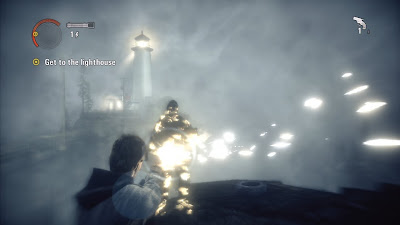
For shadowing the game uses a combination of high and low resolution shadows, both static (pre-baked) and dynamic. The ones used in doors are most noticeably low res, as are some of the dynamic shadows cast by the players touch as they explore Bright Falls. However in outside areas, in which there is so many other effects going on, it’s incredibly hard to notice the odd poor quality shadow.
The games lighting also helps to back the mixture of shadow quality and various other visual effects. Light given off by the players touch casts shadows from objects all around the environment, as do flares and flashbangs, which dynamically change the surrounding shadows. This is perhaps the most impressive thing in Alan Wake’s graphics engine, the uniformity between light and shadow, the dynamic interaction between both, and how this helps create a beautifully organic look to the visuals on offer.
It is safe to say that the quality of these effects on offer in Alan Wake is perhaps some of the best we’ve seen in any console or PC title to date. Resolution issues aside, the consistency and quality seen here is a pretty impressive feat, given the constraints the developers have had to work with and the many issues faced along the way.
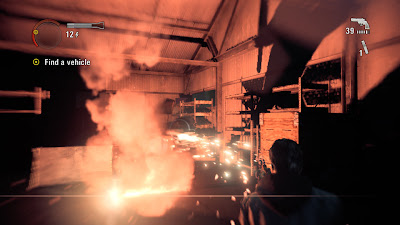
Overall the tech behind Alan Wake is extremely impressive. The game is at times combining several different transparency heavy effects together, along with a fully dynamic lighting and shadowing system, whilst maintaining incredibly high draw distances at a near perfect 30fps.
Certainly, things have been sacrificed in order to achieve this level of visual performance, but those sacrifices haven’t damaged the game in any significant way. In fact, most of the issues caused by the low resolution effects and 540p rendering resolution are barely noticeable during most of your time spent in Bright Falls, which is spent in a surreal world of darkness. This darkness helps hide much of the game’s graphical shortcomings, blending them in, and actually increasing the level of immersion to be found all through Mr Wake’s adventure.
Remedy, like with all the most highly talented developers, have shown just how to work in and around any limitations of the current platform they are developing for, making concessions in certain areas, whilst scaling back in others to ensure that the whole visual make up is as polished as it is balanced.
Alan Wake in this regard, represents exactly the right design choices made for the game at hand. Generating atmosphere to completely embody the player is paramount to the experience, and is something that the developers have achieved with the underlying engine behind the game. It isn’t always about getting all the elements together in the most technically advanced way possible. But instead, about making sure that each of the individual pieces fit together succinctly, and not just as separate visual standpoints in which to admire.
In conclusion, there’s no doubt that Remedy have achieved exactly what they have set out to do with Alan Wake, creating a game which is as gripping as it is visually alluring. For all the use of high-end tech that is powering the game, it is the carefully and often cleverly crafted nature of the art design which makes the package such a success. And whilst it may not have all the high definition goodness of Sony’s Uncharted 2, it more than matches it in sheer technical brilliance and pure artistic direction.

Incredibly deep review! Keep this way!
ReplyDeleteI positively venerate celebration of a mass your blog posts, a accumulation of essay is smashing.This blog as common was educational, we have had to bookmark your site as well as allow to your feed in feed. Your thesis looks lovely.Thanks for sharing.learn technical analysis
ReplyDelete